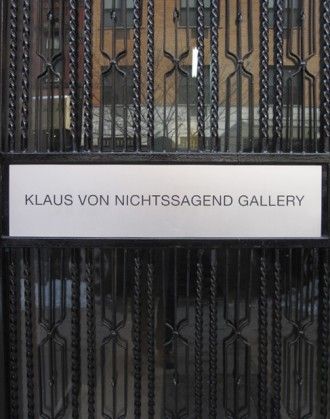
Klaus von Nichtssagend Gallery
Klaus von Nichtssagend Gallery opened in Williamsburg, Brooklyn in September 2004, relocating to New York City’s Lower East Side in January 2011. The gallery is owned and directed by Rob Hult, Ingrid Bromberg Kennedy, and Sam Wilson. In our conversation, Rob Hult and Sam Wilson offer their wide-ranging perspective on running the gallery.
On the Gallery’s Early Days
Sam Wilson: When we started the gallery, we were all working artists and we were showing artists that were friends of ours from art school. Rob and I were classmates at the Rhode Island School of Design. Ingrid went to CalArts. There was a conversation that we were all having in our studios and we were excited about each other's work, and bringing that conversation to an exhibition space. We were really coming at it from the perspective of artists. We decided, very early on, not to show our own work because we felt the gallery was a separate project from our own studio practices.
Rob Hult: Because we had a small storefront in Williamsburg, it wasn't intimidating to do a solo show for a recent art school graduate, even if they worked a day job. We were dedicated at that point to seeing what people could do when they had the entire space to themselves. We were hands off in terms of any kind of direction. It was exciting, but we had no real long-term plan in mind for running a gallery.
But the gallery evolved. Much of our early audience were artists that we knew, and some were also writing and they became interested in what we were doing. There was some word of mouth too and critics started coming to the gallery, and our audience grew. In 2006, we went to Miami to check out all the fairs going on down there, and we thought it would be good for the artists we were working with to participate. The first one we did was NADA in 2007. We brought literally everybody that we had worked with to see what would happen. It was a significant investment-- almost a year’s worth of rent for what we were paying for our Brooklyn storefront-- but we realized that we needed to step up to promote the artists’ work. It was (and remains) a learning curve.
Sam Wilson: When we did the NADA fair in Miami, it was the first time we experienced up close how other art dealers talk about art and sell art. But even though we did not have any real professional experience when we started the gallery, we had a professional attitude and behaved with a sense of fairness and common sense. We developed press releases, created a mailing list and sent invitations for the shows. All three of us had a sense of commitment from very early on. And when you are serious about your work, people start paying attention.
On the Ecosystem - Conversations with Other Galleries
Sam Wilson: Things really changed for us when we moved to the Lower East Side in 2011, because of the community we felt was forming among the galleries located there. It felt like an off-shoot of the community we found at the NADA fair. We are all running our individual businesses, trying to sell work to many of the same collections and fill the same limited space for reviews in publications, but we are also collaborators and help each other out. Though it can be stressful, there is a friendly competition. It is motivating, it is exciting, and it is fun.
I think this relationship between galleries is an interesting part of what we do. We go to other galleries and see their shows. You can't really have a conversation with other galleries unless you know what they are showing and how they are operating. You have to be engaged.
Rob Hult: Yes, we do see many shows for our own interest and education but also to keep the conversation going. We interact with art dealers who have had galleries for many years and art dealers who are just starting out and are curious about other programs. In conversations with other galleries, we also reach out to each other for advice.
I see this as being part of a wider conversation. We live in this super rich cultural environment here in NYC and it would be insane not to take advantage of that. Sometimes we get comfortable in our own social circles and we don’t take a step out to explore. I think the more you interact with people, the better. It helps you see things and form relationships.
On the Gallery’s Program
Rob Hult: As a gallery, because of our interests and our personalities, we are often attracted to artwork that is ambiguous, that may elicit a wide range of ideas and concepts. It’s interesting to hear how different people respond to these works and how they come up with their own individual interpretations, in some ways making the work their own. We often hear reactions that might not have occurred to us.
Sam Wilson: Our interests are also reflected in the way we phrase our press releases. We have a standard approach, that is to say we try not to interpret the work. We try to describe it and let people know what they are going to see at the show. It is interesting to us, when people come to the gallery, to hear what they think of the work rather than to tell them what to think of it. We all appreciate that aspect of conversation around artwork. I think this is a nice way to have a conversation with people and I also think that is rather dangerous when you get into telling people how to look at things. I believe the work should to some extent speak for itself. Maybe there's some background information that can go in there but I think it should be information as opposed to interpretation. I don’t think it is part of the gallery’s role to interpret the work.
On Their Conversations with Artists
Rob Hult: The gallery is a way for us to engage with other people and to have conversations around art. We are constantly having conversations with artists and some of these conversations stretch out over years. It is fascinating to get to know someone’s work and see how it has changed and evolved over a decade, sometimes even longer. We can see how the artist has approached their work from different angles. And sometimes, during studio visits we don’t see the work the way the artist sees it. It’s nice to go back over a period of time and get to know an artist’s process beyond just individual works of art. People come with a wide range of backgrounds and experiences, and sometimes you connect with someone based on their own experience as a maker or by talking to them at the concept level. I have been in New York for fifteen years and I’m still introduced to new artists, even ones who have been working in the city for a lifetime. I feel like we’re lucky to be able to meet artists and learn about different perspectives and practices-- it never stops being interesting.
Sam Wilson: In the art world it is easy to think that you can separate people into “an artist”, “a curator,” “a collector,” “a writer” etc. There is a tendency to fit people into categories. But as we see, the person who comes to the gallery might be an artist and a collector or a writer. A gallery’s artists may also have multiple hats. Curators at museums frequently started as artists. There is a lot of overlap. Once you accept and appreciate that about the art world, then it makes the conversation so much richer because you can talk to people on multiple levels. When you see things separately it solidifies everything and there is not enough movement to get excited about.
Each artist we know is working on something different, so the conversation changes from artist to artist and this is very exciting for us. I frequently think of artists as scientists. Artists are in their studios and they are working on issues that are of interest to them. Because they are approaching their practices differently, working with all these different artists keeps your brain engaged. The gallery artists are deeply involved in what they are doing. Many of our artists come to us, bouncing ideas around and sometimes it feels very collaborative. It is a very close relationship. These conversations may be helping them to develop their practice. I think artists need to have conversations, to get more eyes on the work, in order to see how the work is perceived and received by people. We get to be on the frontline of that. We are frequently the first people they call to see the work. With these conversations, we feel that we know the artists’ work better than anybody else and this is something that we feel really lucky about.
The transcribed text has been edited for length and clarity.
Lilia Ziamou is a visual artist based in New York
